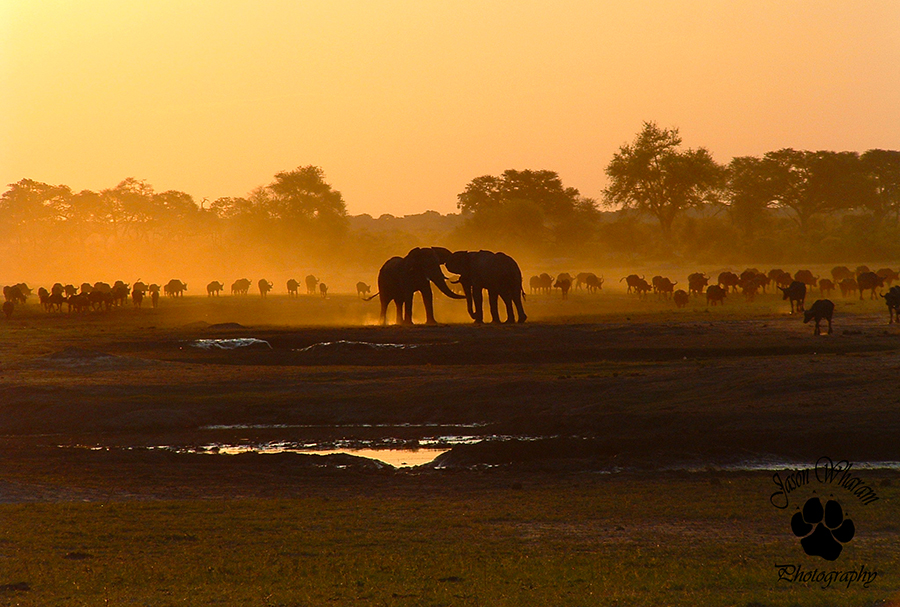Elephants at sunset, Kennedy Vlei by Jason Wharam.
The following is a shortened version of an article by Terry L. Anderson. It appeared in The Wall Street Journal on October 25, 1991.
On a recent trip to Southern Africa, I was pleased to find thriving wildlife populations. For example, in the Zambezi River Valley of northern Zimbabwe – an area twice the size of Maryland – there are 2,000 elephants, 56,000 cape buffalo, 2,000 lions, 230,000 impala, and 50,000 warthogs. Can a developing country such as Zimbabwe maintain them? A market-based program holds promise, and provides lessons for the U.S. as well.
As regions develop, forests are cleared for crops; cattle displace wildlife. This often leads to depletion of soil fertility, soil erosion, and desertification. Throughout southern Africa, traditional communal land tenures have been replaced by fields separated by barbed wire; wells and dams have moderated the pressures from drought but also have reduced wildlife habitat.
Believing that markets are the heart of the problem, many environmental groups advocate suppressing markets and prices and substituting an “environmental ethic.” For example, many governments – taking their lead from such groups – have signed the treaty that bans the ivory trade in order to save elephants.
Such approaches, however, offer little hope for long-term success because they fail to address the incentives faced by individuals trying to survive. Fidelis Lungu, a wildlife manager in Zambia, tells about his experience taking an elephant poacher to court. The judge asked several local villagers to testify. When asked why they helped the poacher, one responded that he received a bag of sugar; another, that he received a pair of pants. Under such subsistence conditions, an environmental ethic easily gives way to survival.
While visiting researchers with the World Wildlife Fund’s Multispecies Project in Zimbabwe, I learned about an alternative to trade bans. Zimbabwe’s Department of National Parks and Wildlife Management has developed a program that shifts responsibility for wildlife management from the state to local councils. Known as Campfire (Communal Area Management Programme for Indigenous Resources), the program is based on the principle that the benefits from wildlife must go to those who pay the financial and social costs of having to co-exist with wild animals: Locals are encouraged to “profit” from wildlife resources.
The Nyaminyami District Council, which initiated the Campfire program in 1989, sold permits that year to hunt 14 elephants, 82 cape buffalo and 26 lions and leopards. These permits generated more than $120,000 in 1989. In addition, meat from sport hunting and herd reduction was provided to the natives, and compensation for damage to crops and livestock was paid.
A report from the World Wildlife Fund estimates that the total “wildlife dividend” in 1989 – the profit from these programs – increased household incomes by 15% to 25%. Though the program is still in its infancy, it appears to reduce poaching and habitat destruction, as the local people begin to view wild animals as a valuable asset.
Wildlife in the United States could benefit from the innovations of Campfire. Although some American ranchers are able to earn money from wildlife by charging fees for hunting access, in most instances state agencies maintain control over wildlife management. As a result, those who bear the cost – such as ranchers whose crops are eaten by deer and elk – often have little opportunity for wildlife dividends.
An exception is the White Mountain Apache Reservation. As long as elk are within the Arizona reservation’s boundaries, they are the responsibility of the tribe, and the tribe is managing the wildlife for profit. Careful monitoring of animals and their habitat has enabled tribal wildlife managers to sell approximately 50 permits per year for bull elk, at $15,000 each. (Even at that price they have a queue.) The revenues and jobs provided to tribe members give them a direct incentive to husband their wild animals. By establishing a local proprietary interest in wildlife, including the ability to profit from it, it is possible to sustain wild animal populations in the face of development. In short, what is economical is also ecological.




